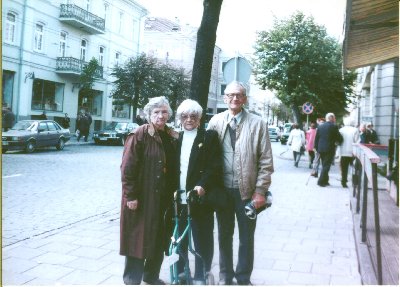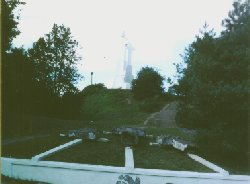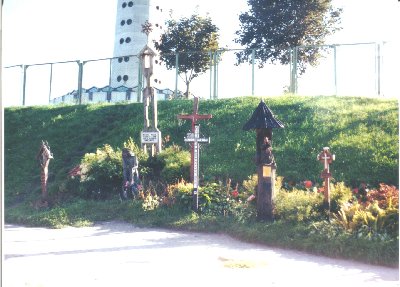|
|
|
Although I got up at 6:30, I skip my run because we want to get an early start on today's trip to Vilnius. These blynai with fruit (and the clotted cream) are addicting. And I do enjoy the rye bread, cheese, and ham - with real butter. Maybe I should have gotten up at 5:30 and managed a run! While we pause in the lobby to pay for last night (we pay for our room each morning, unlike at a U.S. hotel), I learn that the landlady painted the dark and lovely beach scene on the lobby wall. She is quite talented.
We watch the U.S. beat Lithuania in basketball (but not by much). Of course, we were pulling for Lithuania. Vytas and Elyte arrive, then the same Litinterp driver we've had most days. And we head east on the A1 to Vilnius.
At first the land is quite flat; then it begins rolling into hills. Although there are factories and the energy city Electrikai, built by the Soviets, there are many vacation homes, small farms, fields where people are harvesting feed beets and potatoes, cows tethered along the roadside, horse drawn wagons right on the highway, and people riding bikes - in the center median, facing traffic!! We even pass a lake with a floating island. It has bushes and trees growing on it, so it's not just a little clump of grass. And it covers some serious distance on a good-sized pond. I'm so glad Elyte and Vytas can join us in these travels around. If we just went alone with a driver, we'd miss things like this strange island.
Vilnius, the capital. Off on the horizon, the infamous TV tower where the Soviet tanks rolled in - and over one young unarmed woman. The tower includes offices and even a sky-high restaurant, and it does control the broadcast of all the TV stations (unlike in the U.S.). Vilnius grows around us. It has half-again as many people as Kaunas, but it seems larger. Kaunas seems like a center with a collection on mini-cities or sort of villages. Vilnius seems all one large municipality. But that might just be because I've seen Kaunas in much more depth.
 |
In the middle of the old section, near embassies and the Vilnius cathedral, we meet Liuda and her husband Kazys Sadunas. We're meeting here because they live in an apartment that is up too many flights of stairs for Mom to climb. (So Mama and Tete's climbing to the 3rd floor of their 3-decker was not so odd. We modern Americans have become such wimps. Even young folk expect an elevator instead of stairs.) |
We settle into a Mexican restaurant, Vidulienis, that looks like a bunch of caves with lots of dark oak, leather, and all. Why am I surprised at such a restaurant in Lithuania? Heck, here in Durham, we have Greek, Italian, French, Mexican, Chinese, Japanese, Irish, Egyptian,... eateries. The food is fantastic (Do you notice a liet motif in this journal?): the Chicken Salad is roast chicken on a sort of julienned Lithuanian salad with a peach-vinegar dressing. Naturally, I have alus; Mom prefers the red wines, but I definitely prefer the beer. Then we all have coffee and dessert: tortes of thin cake, thick strawberry Bavarian, and a dusting of bitter chocolate. As usual, not sweet, but wonderfully rich.
 Kazys |
Liuda (Liokadija) is the oldest daughter of Mama's sister Juze Sipaviciene. She's Valenitna and Juze's sister. Like Valentina, she was a partisan - and also has the special passport and official pass. However, unlike Valentina, Liuda was captured and sent to Siberia for her resistance to the Soviets. Kazys was also exiled, because he was an engineer; therefore an intellectual and bourgeois. The only good thing about it is that Liuda and Kazys met and married in Siberia - and survived to return to Lithuania. Mom has a great time discussing family and getting to know a cousin she would love to have known all her life. I think they are the closest in age and would have been friends as well as relatives. |  Liuda |
I am constantly amazed at what Lithuanians, and my own family, have endured. And I can't help thinking of how few Americans will bother to vote this November. We do not appreciate how fragile freedom is, how much of a responsibility it entails. We have had it too easy too long I think. But then I wonder about the number of people whose parents were denied the right to vote but who can't be bothered to do so when it is so easy. (OK, this was before a certain person won a certain state, therefore a certain election, partly because people tried to vote but were denied the right. And then a certain court decided that such a problem did not really matter. And, strangely, we have not had a revolution - yet. Is it that we still don't think it is important enough?)
But we have to say good-bye. The driver returns and we take a little tour of Vilnius. We pass the Gediminas Castle, on a hill behind the cathedral, and drive up to the Hill of Three Crosses. The Soviets destroyed and buried the crosses on this hill that commemorated Lithuanian martyrs (surprise, surprise). But, the Soviets being past history, new crosses stand atop the hill, overlooking the city, and the remains of the old crosses form a monument at the parking area. And the top of the hill offers a panorama of this great city.
 The new crosses are white marble against white clouds: almost mystical |
 The TV tower is the spire on the right of the horizon. |
St. Ona's church is the one that Napoleon said he wished he could carry back to France in his hand. The brickwork is fascinating, beautiful, and incredibly intricate. Were the church white, you'd say it was made of spun sugar. But it is of substantial brick - so it is unlike anything I've ever seen. We drive Around the Center and the Old Town, past international embassies, historic churches and statues, and through weekday crowds of business people and shoppers. How can a city be so modern and so historic all at once. I could spend a week just potsying around here. Next visit? |
 |
There is a turgis - a sort of fair - in a part of the Old Town. So we decide to check it out.
 |
We pass a display of beehives woven from reeds, a pottery kiln, a woman at a loom weaving, and walk down past a Lithuanian barbecue. The sign says something like "Fillet Fork", but the meat is skewered on a pitchfork and cooked over a bed of coals in a special (insulated?) versions of a farm wagon. Doing this in a regular wagon would produce a spectacular bonfire! |
| I especially enjoy the children's games. This one involves climbing up a series of wagon wheel. Then the kids decide whether to go down the slide (left) or jump into the wattle barrel-thing of straw. Most chose jumping. |  |
 |
Elyte and Mom stopped at a flax shop. Mama grew her own flax, made it into yarn, wove it into cloth, and made (designed) clothes. She had the first sewing machine in her village because her father was so impressed with her abilities. (She designed many of the fabrics for the mill in which she worked in Lawrence, Massachusetts.) Elyte bought this bouquet of flax (which she shared with us). In the spring, the brownish pods are pretty blue flowers. |
Then we get to the serious part. We drove along the Neris, to the political center of Vilnius - and Lithuania. We visit the Parliament area, where Russian tanks approached the barricades on Bloody Sunday (January 13, 1991). Vytas and I walk around the city block. He and Elyte took their turns guarding other buildings, but the basic story is the same. Unarmed citizens gathered each day to stand guard, in the winter cold, against guns and tanks. He showed me where barrels held fires for them to warm themselves. And the apartment buildings where neighbors came to bring food and hot drinks - and to offer their homes for an hour's sleep.

|  |
These are the remnants of the parliament barricades, left as a memorial. I can't say that being here gave me shivers; the feeling was far more visceral.
 Shrines to all who guarded Lithuania in the face of armed Russians in January 1991. |
 Those whom the Russians murdered in their attempt to reinstate their authority over Independent Lithuania in January 1991. |
We walk back across a large plaza with a beautiful modern fountain and rejoin Elyte and Mom in the car. Next, we head to the infamous TV tower.

| Again, the shrines. They are not majestic or even easy to find. But those who care know where they are. I would not have found either of these memorials were I driving. Or even directing the driver. But Vytas and Elyte lived this history, so they are the appropriate guides. What do other tourists ever learn of this sad history? |  |
Next stop: Trakai. The driver gets lost only once: seriously but not for too long.
| Trakai is a brick castle and palace built by Gediminas in 1321. Later, Vytautas brought his Tartar soldiers here - and their descendents maintain a Tartar community here still. I don't know if this lake started as a moat, or if the castle used the lake as a moat. But it sure looks defensible. There was a sort of amber fair along the boardwalk. But Vytas reminded us that any deal that looks too good to be true, probably is. So Mom & I passed on the tons of "rare" black gintaras. The real stuff is rare; plastic is not. |  |
 |
We walk up to the castle. From the boardwalk, we cross one bridge, stroll through a wooded area, meet a woman renting rowboats to youngsters, and cross the bridge to the castle. Mom and her "hot rod" have put on more mileage today than she walked all last year! |
| It is late afternoon, so we do not opt for a tour. However, just looking in at the gate, we can get a feel for castle life in the 1300s. Again, I am impressed by the brick construction. Also, with no King Henry battling for national control, these relics have survived better. I do wonder why the Soviets did n destroy these national treasures, though. |  |
Heading back to Kaunas, the driver misses a turn and refuses to believe me. Hey, I may not read Lithuanian, but I sure can read a map! Pretending it's what he had intended, he takes us on 21 kilometers of dirt road! Well, we are certainly seeing true rural Lithuania. Beautiful rolling hills, lovely views, and neat little villages and farms. We do, eventually, get back to the A1 and to Kaunas, where we drop Elyte and Vytas off and then relax at Monela.
I take my evening stroll down Laisves al. Can I bring this street home with me? Just a simple souvenir. I could put it right down in the center of Parkwood. It would go so well in the RPT area.
After all our walking at the turgis and at Trakai, we're tired but do want a light meal. So we decide to eat in the kavine at Monela (where we have our breakfasts). And find it filled with an Italian rugby team that is staying here for a tournament. We are lucky to get the one empty table, because some of the lads are late. The waitress asks what we want; there are no menus. The cook comes out and talks with Mom. We will have a dish of rice with peas, mushroom, and melted cheese, and some cucumber, tomato, cole slaw, and dill. Just right.
Now I learn about our driver's conversation today (which has evidently been an ongoing theme of his). Because we visited the sights of Bloody Sunday, and were clearly concerned about the martyrs and about all who defended Lithuania, he has no excuse. He kept a constant monologue to Mom: that the Russians need to come back and take over; that what Lithuania needs is a good war so the Communists can come back and make things right; that everything is now terrible in Lithuania; and that Lithuanians cannot govern themselves; that they are all either crooks or failures..... He's fired. Had I understood Lithuanian, he'd be walking back from Vilnius now. We shared our food with this man, and he insulted my family and this country. There is no way that he will come anywhere near our family meeting and requiem mass on Saturday. Those relatives suffered prison, exile, hiding, death of loved ones; and they were willing to take the risks again to free this country - and that wretched driver. Whether he acknowledges or appreciates it or not.
So, back up in our suite, Mom calls and apologizes to Elyte for me. I am ashamed that I did not understand the driver's comments in time to silence him. Litinterp will either replace him or give me a car to drive myself. Or I'll find another agency that will. I will not have people I love and admire insulted.
Keiren bike racing on the Olympics. In addition to Olympics, we get to watch a talk show format about the Olympics: a cute young blond guy, a dark-haired guy who looks like a young version of our favorite jazz trumpeter, and an odd assortment of guest (none of whom I understand). And then there are the sit coms: American, British, Italian, Spanish, and lots of others I can't identify.... Not actually dubbed - translated as they go by one male and one female. Oddly interesting. Of course, once again, I usually can't understand either the original or the translation.
Back to the Lithuania Journal Page
Back to Nancy's Home Page
Back to the Ciaffone Family Home Page